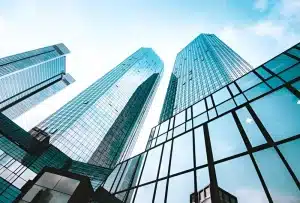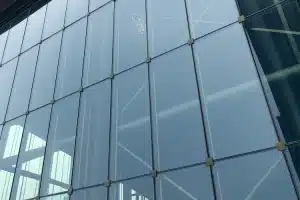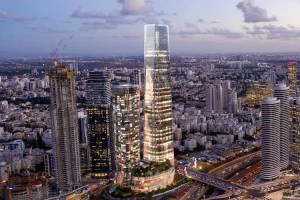
SunFrame’s Global Journey: From “Made in China” to “Created in China”
SunFrame’s Global Journey: From “Made in China” to “Created in China” Introduction For decades, China’s doors, windows, and curtain wall industry has stood as a
As a modern exterior solution for building, curtain wall systems break away from the conventional patterns of brick-and-mortar structures and window-wall combinations. Such an enclosure system is in fact composed of lightweight and high-performance materials. And it is installed directly on the exterior of the building’s main structure, supporting architectural aesthetics. At the same time, it also ensures comprehensive functionality and safety performance.
Categories of Curtain Walls (by application):
In recent years, metal curtain wall systems have seen rapid development. Because they retain the technical advantages of traditional curtain walls while enhancing durability and expanding the possibilities for creative façade design. As a result, they have become a key choice in contemporary architecture.

In recent years, metal curtain wall systems have developed rapidly. Because they not only retain the technical advantages of traditional curtain walls, but also enhance the durability and expand the possibilities for creative façade design. As a result, they now become a key choice in contemporary architecture.
☞ Excellent Performance: Metal panels are featured by the great performance including superior insulation, soundproofing, waterproofing, stain resistance, and corrosion resistance.
☞ High Design Flexibility: Metal materials are highly adaptable to various architectural styles. And so designers can achieve diverse decorative effects.
☞ Lightweight Materials: Because of the lightweight nature of metal panels, structural load is reduced. And this feature also makes them still safe when used in high-rise buildings.
☞ Superior Workability and Aesthetics: Metal panels can be easily processed into different shapes, curves and a wide range of colors. Besides, they can offer excellent safety. All of these elements can greatly expand the creative possibilities for façade designers.

Metal curtain walls are classified based on the material of the panel. The seven main types include:
1
The solid aluminum panels are actually the single-layer aluminum panels. And they are made from high-quality aluminum alloy sheets. The panels must undergo chromating and other surface treatments first. Then, they are precision-formed using CNC bending and coated with either fluorocarbon paint or powder coating. After that, they become a modern architectural cladding material widely used for exterior facades.
According to the surface finish types, solid aluminum panels can be divided into several categories, including:
Typically, the panels are made from 2.5mm or 3.0mm thick aluminum alloy sheets.
① Excellent durability and corrosion resistance
– Fluorocarbon coating lasts up to 25 years without significant color fading.
② Lightweight yet strong
– A 3.0mm thick panel weighs approximately 8kg/m², with tensile strength between 100–280 N/mm².
③ Highly formable
– Can be fabricated into flat, curved, or even spherical geometries, suitable for complex architectural designs.
④ Low maintenance
– The non-adhesive nature of the PVDF surface makes it highly resistant to dirt and easy to clean.
⑤ Eco-friendly and recyclable
– 100% recyclable with high residual value, promoting sustainable construction practices.
The facade of DEPO Shanghai Book City WE, designed by Wutopia Lab, features a striking cladding made of 500 white aluminum panels in three different widths: 160mm, 320mm, and 480mm. Each panel’s length was algorithmically generated based on the designer’s sketches. And that results in a unique random form across the surface.

To create a rich and layered visual effect, the facade is composed of three cascading layers including inner, middle, and outer — reminiscent of a waterfall. The outermost layer cleverly conceals a canopy, keeping both aesthetic continuity and functional performance. Indoors, the design language continues: steel bookshelves mimic the rainfall motif, creating a seamless transition from exterior to interior.

2
Aluminum composite panels mainly consist of aluminum alloy sheets and a central core material. And these two materials are combined by a high-performance polymer adhesive film. A typical ACP for building façades is made of two 0.5mm-thick aluminum skins with a 2–5mm-thick polyethylene (PE) or rigid PVC foam core in the middle.
In general curtain wall applications, the standard core thickness is 3mm. ACPs are commonly installed using open-joint façade systems, allowing for quick installation and lower construction costs.
① Lightweight with High Strength
– A 4mm thick ACP can achieve stiffness up to 2400 kN·cm²/m.
② Excellent Impact Resistance and Flexibility
– Tough surface coating remains intact even when bent; highly impact-resistant.
③ Versatile Fabrication
– Can be cut, routed, grooved, sawed, punched, countersunk, cold bent, rolled, riveted, screwed, or bonded. Panels can be shaped into curves, angles, or other forms. This feature offers great flexibility for architects and designers.
④ Superior Fire Performance
– The core consists of flame-retardant or non-combustible mineral polymer materials, with aluminum skins that are inherently difficult to ignite. Fire ratings can reach Class B1 or A2.
The outer façade of the Chengdu Supercomputing Center is clad in color-shifting aluminum composite panels, enclosed within a massive cable-supported glass curtain wall structure. Visitors can walk along a transparent glass promenade encircling the building, experiencing the sheer scale of one of the world’s top 10 supercomputers. The deep, pure blue surface of the monolithic structure evokes the atmosphere of a science fiction film.

The giant glass box surrounding the “Silicon Cube” utilizes a large-span single-cable curtain wall system, ensuring both transparency and structural clarity. With its futuristic geometry and striking visual identity, the Silicon Cube becomes an iconic landmark that reflects the forefront of technological innovation.

The rear power and operations buildings feature double-skin curtain walls, with the outer layer composed of aluminum panels arranged in a square pixel grid. Through the interplay of perforated and solid units, the pattern abstractly represents the binary logic of “0” and “1” — the foundation of all digital computing. A massive silver-and-white volumetric corner anchors the visual boundary of the site, symbolizing the pulse of ByteDance’s cutting-edge tech infrastructure.

3
Aluminum honeycomb panels are engineered applying a “honeycomb sandwich” structure. That is a high-strength aluminum alloy skin is bonded to a central aluminum honeycomb core through high-temperature and high-pressure lamination. For curtain wall applications, only aluminum honeycomb cores are used. The honeycomb cells are in different shapes, including regular hexagons, flat hexagons, rectangles, squares, crosses, and flattened squares.
According to the required performance and service life of the façade, common honeycomb panel thicknesses can be 12mm, 15mm, 20mm or 25mm.
The façade of Qin Garden features a sophisticated combination of aluminum honeycomb panels and deep-toned European grey glass. Fine aluminum profiles are used to articulate the sleek geometry between the opaque honeycomb surfaces and the expansive low-E glass. And that has formed a light and transparent architectural expression.

The use of dark grey hues makes the façade harmonized with the surrounding environment, avoiding stylistic dominance. The contrast of understated metallic finish of the aluminum and the high-reflectivity mirrored glass shows a dynamic play of light and shadow throughout the day. This interplay evokes infinite imagination and spatial fluidity, achieving an artistic vision where the form transcends its literal presence.

4
The insulated aluminum sandwich panels is similar to the honeycomb and aluminum composite panels in terms of the structure. But their difference lines in their core materials. These panels typically are made by aluminum sheets and insulation materials like expanded polystyrene (EPS) or rock wool. Besides, they have the functions including both thermal insulation and aesthetic appeal.
As a new generation of energy-efficient building materials, they are prefabricated in the factory by laminating fire-resistant insulation boards (e.g., EPS or mineral wool). So that it can ensure high levels of standardization, customization, and performance.
① Lightweight and easy to fabricate, offering lower material and installation costs.
② Quick to install, significantly reducing construction time.
③ Excellent fire resistance, waterproofing, and thermal insulation properties.
The Hangzhou Coral Century villas utilize integrated insulated aluminum panels for the exterior façade, increasing the insulation layer thickness by 20 cm. However, this feature is not visible. It can only be felt when people are indoor that this design decision significantly enhances indoor comfort.
Thanks to this hidden thermal envelope, residents can fully enjoy the panoramic views offered by floor-to-ceiling glass windows. There’s no need to sacrifice temperature control or energy efficiency. This balance of performance and design reflects a deep understanding of both form and function in architecture.

5
Stainless steel panels have a smooth surface and exceptional strength. Because of those reasons, they are ideal for high-rise and supertall buildings. Their excellent ductility allows for bending and curving. So that a wide variety of architectural expressions can be expressed. In terms of common finishes, they can be divided into mirror-polished, brushed (matte), and titanium-coated stainless steel panels.
When used as a single-layer cladding panel, a minimum thickness of 1.5 mm is required. For panels under 2 mm thick, it is recommended to limit the short-edge dimension to avoid surface waviness or deformation.
① Because of the durable alloy steel that resists rust, they are highly resistant to corrosion from acids, alkalis, solvents, and other harsh environments.
② They can offerhigh strength, rigidity, weather resistance, and long service life with minimal maintenance.
③ Features of excellent formability, toughness, and mechanical strengthare ideal for complex and expressive architectural designs.
The DreamWorks project in Shenzhen includes a fan-shaped main building and a triangular annex. The main building serves as the theater’s audience seating. While the annex integrates the stage, classrooms, offices, and other supporting spaces.

After renovation, the open corridor behind the façade is enclosed by a custom metal curtain wall system. It’s “woven” from vertically-mounted brackets and curved stainless steel panels, shaped into reverse arcs. The result is a dynamic surface that subtly captures and reflects light, creating a rhythm of shifting tones across the curved geometry.

The spacing of the curtain wall’s supporting frame strikes a delicate balance between proportion and pattern, while the precisely perforated stainless steel panels form a breathable, translucent texture — both functional and artistic.
6
Color-coated steel panels are steel sheets with an organic coating layer applied to the surface.
They mainly come in 3 surface finishes: painted, embossed, and printed textures.
Base materials include cold-rolled steel, hot-dip galvanized steel, and electro-galvanized steel.
According to the coating types, they are classified into: polyester (PE) and silicone-modified polyester (SMP) to polyvinylidene fluoride (PVDF) and plastisols.
① They are flexible, decorative and available in a wide range of vibrant colors and modern finishes.
② Lightweight yet strong, with excellent performance like waterproofing and seismic resistance.
③ Highly corrosion-resistant and easy to fabricate and form.
④ They are durable, space-efficient, and recyclable. For that, it is an environmentally conscious choice.
At the KIKS store in Beijing, core display zones, clothing racks, shoe cabinets, and partition walls are arranged sequentially within a thematic space. These structures are adjustable, rail-mounted, and fully modular.

The movable partition walls are crafted from hand-painted color-coated steel panels, inspired by the fusion energy generated on the surface of the sun. These panels underwent dozens of material experiments, including saltwater exposure, chemical soaking, manual polishing, natural rusting, and layered stencil spraying. The final design balances texture, color, and durability, resulting in a truly expressive and functional solution.
7
Vitreous enamel steel panels are made from 1.6mm-thick ultra-low carbon steel, whose carbon content is just 0.004% (compared to the standard 0.060%). After repeated acid cleaning, the steel surface is coated with a powdered glass frit. And they are finally fired at 850°C to form a smooth, durable enamel finish.
① Exceptional performance: smooth surface, high hardness, and a contemporary architectural aesthetic.
② Vibrant colors & patterns: customizable in a wide range of hues and designs, offering strong visual appeal.
Located in Zhangjiang Hi-Tech Park in Shanghai’s Pudong district, the HOW Art Museum has a 4,200 sqm exhibition hall and 2,800 sqm of office and service areas.

The entrance lobby of the HOW Art Museum is designed to convey a sense of “light landing” in its massing. The form is kept clean and minimal, composed of a single folded volume with a direct planar turn. Its angles align closely with the original building façade, creating a seamless architectural integration between the new and existing structures.
Inside, the design continues this language of purity: white enamel panels line the interior walls, hardened concrete covers the floors, and clean, precise lighting preserves the integrity of the gallery space.

As the only art museum in Shanghai open at night, HOW Art Museum is more than a cultural venue — it forms part of a larger creative ecosystem including the HOW Art Hotel, HOW Design Center, and HOW Sculpture Park, marking it as a new cultural landmark in Pudong.

SunFrame’s Global Journey: From “Made in China” to “Created in China” Introduction For decades, China’s doors, windows, and curtain wall industry has stood as a

Beyond Glazing: Designing for Solar Control in Airport Facades In airport design, managing sunlight is never just about choosing the right glass — it’s a design

Seismic Curtain Wall: 9 Acceptance Standards for Flexible Connectors Introduction In Mexico City, an ordinary morning can be transformed within seconds. The ground begins to

Building Resilience: Lessons from Israel’s Tallest Tower for SunFrame Curtain Wall Strategy Introduction Building resilience in extreme environments is no small feat. Amid conflict and